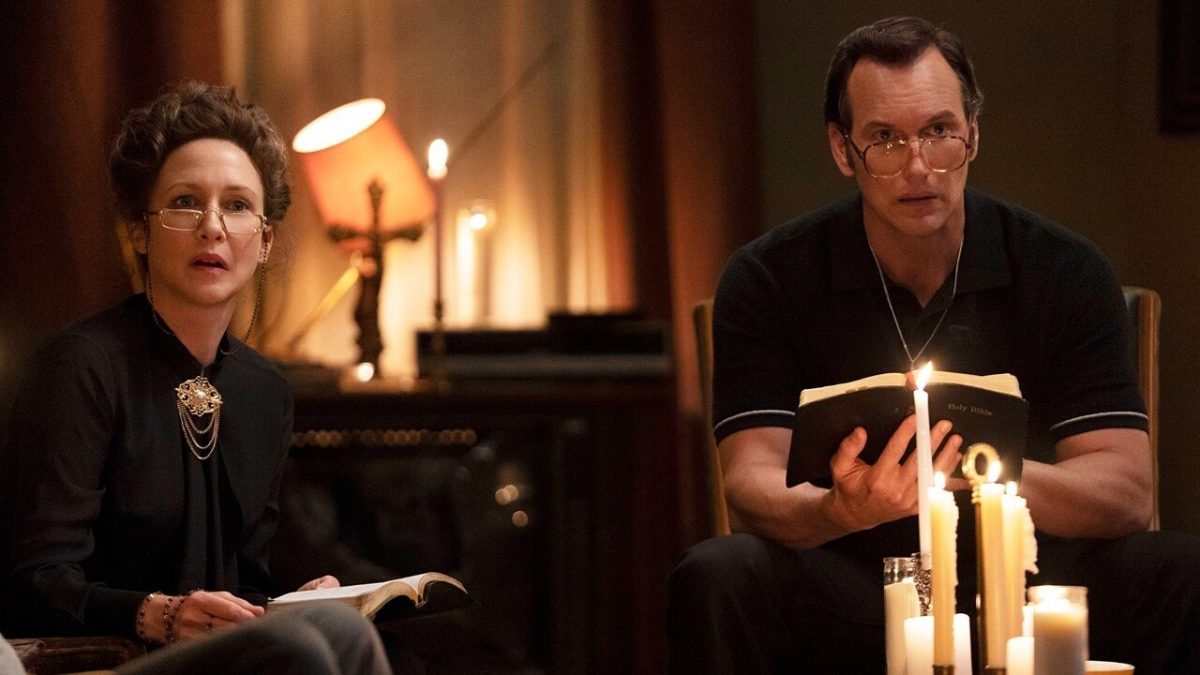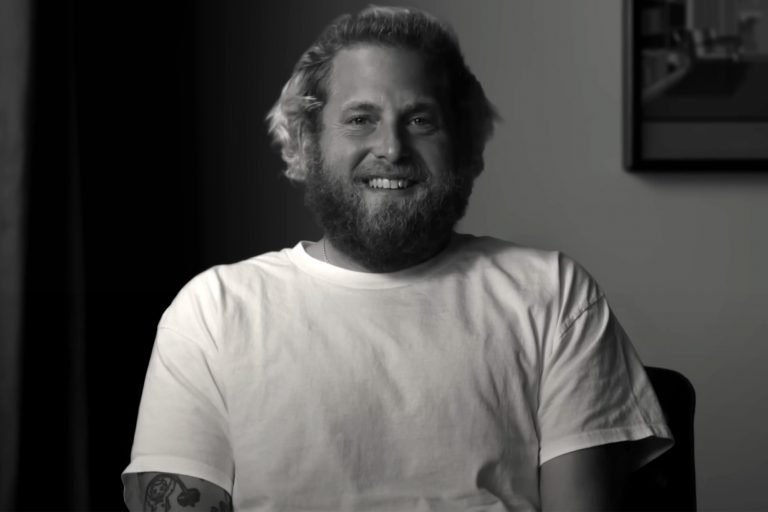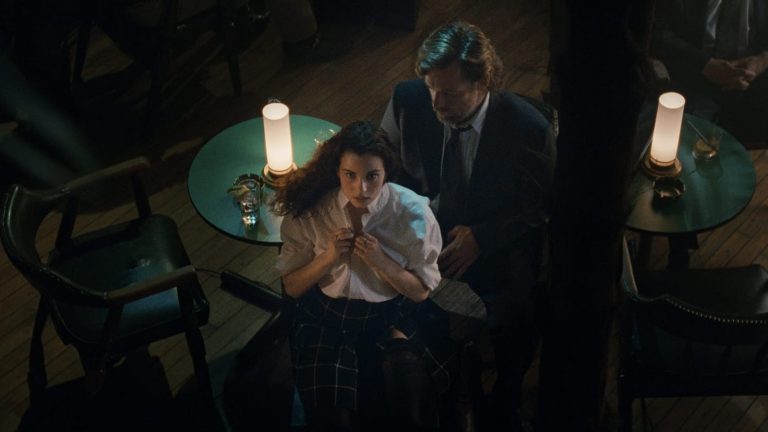“The Conjuring: Last Rites” (2025), directed by Michael Chaves, brings a poignant close to one of horror cinema’s most enduring sagas. What began in 2013 with a haunted farmhouse in Rhode Island now culminates in a spiritual reckoning for Ed and Lorraine Warren — not against a single demonic force, but against something far more human: the fear of losing each other and their daughter.
This final chapter trades the franchise’s signature relentless dread for an unexpectedly tender farewell, weaving the Warrens’ history of faith, sacrifice, and devotion into a supernatural tapestry. At its heart, “Last Rites” is a story of inheritance — of power, of pain, and of a love fierce enough to blur the boundary between the mortal and the divine.
The Conjuring: Last Rites (2025) Plot Summary & Movie Synopsis:
Why Did Judy’s Birth Turn Supernatural?
The film’s opening sequence sets its emotional foundation. In 1964, a pregnant Lorraine experiences unbearable pain while working a case with Ed. She’s rushed to the hospital, where their daughter Judy was born. When doctors declare the baby dead, Lorraine clutches her lifeless child and prays with desperate conviction — and in a moment defying science, Judy emits her first cry.
This miracle establishes the film’s central motif: Lorraine’s love as both weapon and shield. But it also plants a lingering unease. The Warrens’ life has always been intertwined with the supernatural, and Judy’s resurrection hints that she may have been touched by the very forces her parents battle. Whether divine intervention or cosmic interference, Judy’s rebirth becomes both blessing and omen. Lorraine senses that something — or someone — wanted Judy’s life to begin for a reason.
How Does Judy’s Possession Reflect Her Parents’ Fears?
Decades later, Judy is going to marry Tony Spera (played with grounded sincerity), a former police officer who once survived a near-fatal shooting. Tony’s brush with death mirrors Judy’s own rebirth, making him a natural counterpart — a man marked by fate, drawn to the Warrens’ world even before he fully enters it. Lorraine and Ed’s overprotectiveness, especially Ed’s skepticism toward Tony, stems not from distrust but fear of repeating their past — that their daughter might be pulled into the darkness they’ve spent their lives containing.
That fear becomes prophecy when Judy begins to sense a presence around her, culminating in visions of Father Gordon’s death and whispers from beyond. Her psychic link to her mother manifests as both a gift and a curse. The Warrens’ greatest strength — their ability to see what others cannot — is now haunting their own child. When Judy is later possessed, it’s not merely a supernatural attack. It’s a confrontation between generations — a child inheriting the weight of her parents’ faith, forced to decide whether she’ll carry it forward or be crushed beneath it.
What is the Smurl Case?
The Smurl haunting provides the film’s external conflict but also acts as a mirror (quite literally) to the Warrens’ internal one. The Smurl family’s home in West Pittston is plagued by poltergeist activity — mirrors cracking, voices echoing, and the appearance of vengeful spirits tied to an old murder on the property. After Father Gordon’s sudden suicide, the Warrens are drawn back into the field, reluctantly investigating the Smurl case despite Ed’s fragile health.
Lorraine quickly discerns that the haunting is connected to something far older and darker — a cursed mirror once handled during the Warrens’ earliest investigation, now resurfacing after decades. The so-called Conjuring Mirror becomes the film’s ultimate antagonist. It doesn’t simply reflect evil — it channels it, storing the hatred and grief of the spirits it once trapped. The Smurls, unwitting victims, are bait; the mirror’s true target is Judy.
The Conjuring: Last Rites (2025) Movie Ending Explained:
How Do the Warrens Defeat the Conjuring Mirror?

The climax at the Smurl house marks not just the emotional zenith of “Last Rites,” but the theological heart of the entire “Conjuring” saga. What begins as a chaotic exorcism transforms into something almost sacramental — a ritual that fuses faith, psychology, and raw familial devotion. When the mirror awakens, the entire house becomes an extension of its will.
Objects move with purpose, light bends unnaturally, and the air grows dense — as though the house itself is inhaling. Lorraine immediately recognizes that what they’re facing isn’t just a haunting but a ritual inversion: the mirror is performing its own kind of anti-mass, feeding on grief and despair. Every cry, every doubt, strengthens it.
Ed, physically frail but spiritually resolute, begins to read from the Book of Revelation, invoking the “banishment of false light.” It’s a prayer he’s used before, notably in “The Conjuring 2” during the Enfield case, but here it falters. The demon mocks him through Judy’s voice, whispering, “Your faith cannot save her, just as it could not save you.”
The line cuts deep — an allusion to Ed’s lifelong fear that one day his belief would fail the people he loves most. Tony tries to pull Judy away, but Lorraine stops him. This is the film’s true turning point — the moment Lorraine rejects everything she once believed about protection. All her life, she has told Judy to close her eyes, to deny what she sees. But this time, she realizes that denial only gives the darkness more power. The only way out is through.
Also Read: Here’s How to Watch The Conjuring Movies in Chronological Order
Lorraine tells Judy, “We do not hide from what God allows us to see. We sanctify it.” Together, they approach the mirror. As they place their hands on the cold glass, the surface ripples like water, showing them their reflections distorted into monstrous forms — Ed as a demon priest, Lorraine as a witch, Judy as a screaming infant surrounded by shadows.
The mirror isn’t showing them ghosts; it’s showing them guilt — every fear and failure they’ve ever carried. This moment functions as the film’s literal rite. Lorraine calls upon not the Church, but the Holy Spirit through love — repeating softly, “In the name of the Father who gave me my child, in the name of the Mother who never abandoned her, in the name of the love that binds us all.” Each phrase weakens the mirror’s hold. The light in the room begins to flicker like candle flames, responding not to incantation, but to emotion.
Ed joins them, clutching his chest but refusing to fall back. He continues reading scripture, his voice cracking as he declares, “Perfect love casts out fear.” Lorraine echoes him, and Judy — finally breaking free of possession — screams the same words, shattering the mirror in an explosion of white light. But it isn’t the shattering that destroys the demon — it’s the completion of their shared faith.
The act of confronting their reflections, acknowledging their imperfections, and loving each other despite them becomes the true exorcism. The last rites they perform are not for the dead, but for the living — for themselves, for their family, and for the lives they’ve touched. When the light fades, the mirror lies in pieces, no longer cursed, its surface reflecting nothing but a family reunited.
Does Ed Warren Die?

In a franchise that has often flirted with tragedy, “Last Rites” spares us the heartbreak of watching Ed die on-screen. He suffers another heart attack during the confrontation, fulfilling the prophecy that another episode could be fatal. Yet, in an act of poetic symmetry, it’s Lorraine’s voice — the same faith that revived Judy decades earlier — that keeps Ed alive long enough to finish their final case.
The aftermath gives us a tender montage: Lorraine’s vision of Judy’s wedding, Ed dancing with his daughter, and fleeting glimpses of grandchildren — a peaceful legacy after a lifetime of war with darkness. We learn through narration that Ed eventually dies years later of a stroke, with Lorraine at his side. It’s not a tragic ending, but an earned rest — the final rite for two souls who have already faced hell together.
What Does the Post-Credit Scene Reveal?
The post-credit scene ties the entire franchise together. We learn that the haunted mirror is the Conjuring Mirror — the object that inspired the series’ title. Used to summon spirits in ancient rituals, it became the symbolic heart of every case the Warrens ever faced. The lingering reflection of real-life Ed seen in the mirror’s surface during this sequence isn’t meant as a scare — it’s a benediction. The mirror no longer holds evil; it holds memory. The Warrens’ artifact room, once a gallery of cursed relics, now feels like a shrine to endurance, suggesting that Judy and Tony may become the keepers of its legacy.
What Does ‘Last Rites’ Really Mean?
The title operates on multiple levels. On the surface, it refers to the Catholic ritual for the dying — fitting for a couple confronting their mortality. But “Last Rites” also signifies the emotional exorcism of the Warrens’ fears: Lorraine’s fear of losing Ed, Ed’s fear of leaving Judy unprotected, and Judy’s fear of inheriting their burden. Their final rite isn’t an exorcism of a demon; it’s an absolution of grief. By facing the mirror — both literally and metaphorically — the Warrens cleanse themselves of what has haunted them since the beginning: the cost of their calling.
An Overall Impression
“The Conjuring: Last Rites” closes the franchise not with shrieks, but with serenity. It’s a film about the sanctity of love — romantic, parental, and spiritual — and how it endures even in the face of unholy terror. Michael Chaves, often criticized for relying on jump scares, takes a quieter, more introspective approach here.
The result is less a haunted-house thriller and more a requiem — a farewell to the couple who made faith feel cinematic. Ed and Lorraine’s journey ends where it began: in a room filled with darkness, holding each other’s hands, choosing to believe that light still wins. And as the camera lingers on the broken Conjuring Mirror — its surface cracked but no longer cursed — we understand the franchise’s final message. Evil reflects, but love endures.






